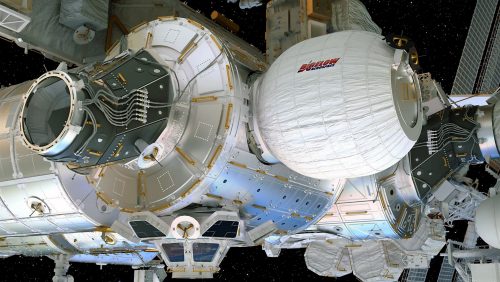In the nineties, NASA developed the idea of Transhab - an inflatable living module for an expedition to Mars, which later evolved into a living room for the International Space Station. This program was canceled in 2000 due to budget constraints, however Robert Bigelow who made his fortune in the hotel business purchased a license to use NASA patents and developed what in the future may be the basis for hotels in space

The astronauts of the International Space Station rejoiced at the arrival of what they call the “Bungalow Bigelow,” or as it is officially called: the Bigelow Activity Area Expansion Module (BEAM) on April 10.
If all goes according to plan, the astronauts using the station's robotic arm will install the module later this week. But it will only inflate at the end of May. It will then remain inflated for a period of two years.
The arrival of an inflatable module to the space station is a significant achievement for the future of spaceflight. This is a major achievement for private companies Bigelow Aerospace, which built the module, and SpaceX, which launched it. In fact, this is a remarkable achievement for a public-private partnership commercializing government-funded research and NASA's strategy to encourage the commercialization of space.
The idea of using an inflatable module in space is not new. In the early sixties, NASA developed the idea of inflatable living cells in space. However, such modules never left the planning stage and were flown into space.
A 1989 idea proposed putting inflatable modules on the moon that would be used for habitation, a fully equipped life sciences laboratory, a selenology (lunar geology) laboratory, officers' quarters, crew quarters, dust removal devices and an airlock for going to the lunar surface.
In the nineties, NASA developed the idea of Transhab - an inflatable living module for an expedition to Mars, which later evolved into a living room for the International Space Station. This program was canceled in 2000 due to budget constraints.
The close similarity between the concept of Transhab and BEAM is not accidental; Bigelow's inflatable cells evolved directly from Transhub. Robert Bigelow, who made his fortune in the hotel industry, founded Bigelow Aerospace in 1998. In 2003, he signed with NASA T a license to use NASA patents related to Transhub's expanding habitats.
The company built and launched two experimental modules - Genesis 1 and Genesis 2 in 2006 and 2007. These modules are still in orbit today and transmit images, videos and data. These are the cheapest satellites ever launched into space.
While the astronauts on the International Space Station may want additional living space 4 meters long and 3.2 meters wide, for the purpose of the experiment the room will remain unmanned during its deployment on the International Space Station.
The main purpose of installing the module for two years is to test its safety for future use, including radiation protection and uploading and installation procedures.
During these two years, the module will be under close supervision of its structural integrity, its temperature control, its resistance to micro meteorites and other leakage factors.
Bigelow and NASA also signed an agreement to develop the next B330 model, which will have a volume of 330 square meters, much more than the 160 meters of the Destiny module currently used to house the astronauts on the space station.
On April 11, 2016, just one day after the BEAM launch to the International Space Station, Bigelow signed a partnership with United Launch Alliance to launch two B330 modules. with the first module launching in 2019 and the second in 2020. These modules will serve as the first commercial space colonization capability research facilities. Bigelow also does not rule out attaching the next model to the International Space Station and other space stations.
The B330 modules will first be tested in low orbit around the Earth, when the strategic goal is to integrate such modules in deep space missions - to the Moon and Mars. However, the company's real profits will come from space tourists who will request to fly to one of the inflatable space stations it will build.

2 תגובות
Yossi asked how long Shana's crew stayed in space, that is, in the station, and what they were wondering, and how did it affect them, Avi
It seems to me that structures made of rigid materials still provide more durable protection for astronauts. Obviously, both of them are not resistant to an asteroid at a speed of 30000 km/h for a spacecraft, but a bungalow in space sounds strange to me.